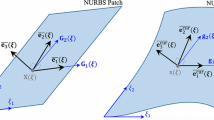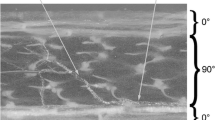Abstract
In this two-part paper we introduce a new formulation for modeling progressive damage in laminated composite structures. We adopt a multi-layer modeling approach, based on isogeometric analysis, where each ply or lamina is represented by a spline surface, and modeled as a Kirchhoff–Love thin shell. Continuum damage mechanics is used to model intralaminar damage, and a new zero-thickness cohesive-interface formulation is introduced to model delamination as well as permitting laminate-level transverse shear compliance. In Part I of this series we focus on the presentation of the modeling framework, validation of the framework using standard Mode I and Mode II delamination tests, and assessment of its suitability for modeling thick laminates. In Part II of this series we focus on the application of the proposed framework to modeling and simulation of damage in composite laminates resulting from impact. The proposed approach has significant accuracy and efficiency advantages over existing methods for modeling impact damage. These stem from the use of IGA-based Kirchhoff–Love shells to represent the individual plies of the composite laminate, while the compliant cohesive interfaces enable transverse shear deformation of the laminate. Kirchhoff–Love shells give a faithful representation of the ply deformation behavior, and, unlike solids or traditional shear-deformable shells, do not suffer from transverse-shear locking in the limit of vanishing thickness. This, in combination with higher-order accurate and smooth representation of the shell midsurface displacement field, allows us to adopt relatively coarse in-plane discretizations without sacrificing solution accuracy. Furthermore, the thin-shell formulation employed does not use rotational degrees of freedom, which gives additional efficiency benefits relative to more standard shell formulations.











Similar content being viewed by others
References
Choi H, Downs R, Chang F-K (1991) A new approach toward understanding damage mechanisms and mechanics of laminated composites due to low-velocity impact: part I-experiments. J Compos Mater 25:992–1011
Richardson M, Wisheart M (1996) Review of low-velocity impact properties of composite materials. Compos A 27A:1123–1131
Choi H, Chang F-K (1992) A model for predicting damage in graphite/epoxy laminated composites resulting from low-velocity point impact. J Compos Mater 26:2134–2169
Allix O, Ladevéze P (1992) Interlaminar interface modelling for the prediction of delamination. Compos Struct 22:235–242
Allix O, Ladevéze P, Corigliano A (1995) Damage analysis of interlaminar fracture specimens. Compos Struct 31:61–74
Mi Y, Crisfield A, Davies G (1998) Progressive delamination using interface elements. J Compos Mater 32:1246–1272
Dàvila C, Camanho P, Turon A (2007) Cohesive elements for shells. Technical report 214869. NASA Langley Research Center
Camanho P, Dàvila C, de Moura F (2003) Numerical simulation of mixed-mode progressive delamination in composite materials. J Compos Mater 37:1415–1438
Yang Q, Cox B (2005) Cohesive models for damage evolution in laminated composites. Int J Fract 133:107–137
Turon A, Camanho P, Costa J, Dàvila C (2006) A damage model for the simulation of delamination in advanced composites under variable-mode loading. Mech Mater 38:1072–1089
Turon A, Camanho P, Costa J, Renart J (2010) Accurate simulation of delamination growth under mixed-mode loading using cohesive elements: definition of interlaminar strengths and elastic stiffness. Compos Struct 92:1857–1864
Ladevéze P, Dantec EL (1992) Damage modelling of the elementary ply for laminated composites. Compos Sci Technol 43:257–267
Matzenmiller A, Lubliner J, Taylor R (1995) A constitutive model for anisotropic damage in fiber-composites. Mech Mater 20:125–152
Dàvila C, Camanho P (2003) Failure criteria for FRP laminates in plane stress. Technical report NASA/TM-2003-212663. Langley Research Center, Hampton
Pinho S, Iannucci L, Robinson P (2006) Physically-based failure models and criteria for laminated fibre-reinforced composites with emphasis on fibre kinking: part I: development. Compos A 37:63–73
Pinho S, Iannucci L, Robinson P (2006) Physically-based failure models and criteria for laminated fibre-reinforced composites with emphasis on fibre kinking: part II: FE implementation. Compos A 37:766–777
Donadon M, Iannucci L, Falzon B, Hodgkinson J, de Almeida S (2008) A progressive failure model for composite laminates subjected to low velocity impact damage. Comput Struct 86:1232–1252
Bouvet C, Rivallant S, Barrau J (2012) Low velocity impact modeling in composite laminates capturing permanent indentation. Compos Sci Technol 72:1977–1988
Tan W, Falzon B, Chiu L, Price M (2015) Predicting low velocity impact damage and compression-after-impact (CAI) behaviour of composite laminates. Compos A 71:212–226
Zhang Y, Zhu P, Lai X (2006) Finite element analysis of low-velocity impact damage in composite laminated plates. Mater Des 27:513–519
Guan Z, Yang C (2002) Low-velocity impact and damage process of composite laminates. J Compos Mater 36:851–871
Faggiani A, Falzon B (2010) Predicting low-velocity impact damage on a stiffened composite panel. Compos A 41:737–749
Hughes TJR, Cottrell JA, Bazilevs Y (2005) Isogeometric analysis: CAD, finite elements, NURBS, exact geometry, and mesh refinement. Comput Methods Appl Mech Eng 194:4135–4195
Cottrell JA, Hughes TJR, Bazilevs Y (2009) Isogeometric analysis: toward integration of CAD and FEA. Wiley, London
Kiendl J, Bletzinger K-U, Linhard J, Wüchner R (2009) Isogeometric shell analysis with Kirchhoff–Love elements. Comput Methods Appl Mech Eng 198:3902–3914
Kiendl J, Bazilevs Y, Hsu M-C, Wüchner R, Bletzinger K-U (2010) The bending strip method for isogeometric analysis of Kirchhoff–Love shell structures comprised of multiple patches. Comput Methods Appl Mech Eng 199:2403–2416
Deng X, Korobenko A, Yan J, Bazilevs Y (2015) Isogeometric analysis of continuum damage in rotation-free composite shells. Comput Methods Appl Mech Eng 284:349–372
Hsu M-C, Wang C, Herrema AJ, Schillinger D, Ghoshal A, Bazilevs Y (2015) An interactive geometry modeling and parametric design platform for isogeometric analysis. Comput Math Appl 70:1481–1500
Hosseini S, Remmers J, Verhoosel C, de Borst R (2013) An isogeometric solid-like shell element for non-linear analysis. Int J Numer Meth Eng 95:238–256
Hosseini S, Remmers J, Verhoosel C, de Borst R (2014) An isogeometric continuum shell element for non-linear analysis. Comput Methods Appl Mech Eng 271:1–22
Wriggers P (1995) Finite element algorithms for contact problems. Arch Comput Methods Eng 2:1–49
Temizer I, Wriggers P, Hughes T (2012) Three-dimensional mortar-based frictional contact treatment in isogeometric analysis with nurbs. Comput Methods Appl Mech Eng 209:115–128
Kamensky D, Hsu M-C, Schillinger D, Evans JA, Aggarwal A, Bazilevs Y, Sacks MS, Hughes TJR (2015) An immersogeometric variational framework for fluid-structure interaction: application to bioprosthetic heart valves. Comput Methods Appl Mech Eng 284:1005–1053
Bazilevs Y, Hsu M-C, Scott MA (2012) Isogeometric fluid-structure interaction analysis with emphasis on non-matching discretizations, and with application to wind turbines. Comput Methods Appl Mech Eng 249–252:28–41
Chung J, Hulbert GM (1993) A time integration algorithm for structural dynamics with improved numerical dissipation: the generalized-\(\alpha \) method. J Appl Mech 60:371–75
ABAQUS (2016) User’s manual. Providence, p 2016
Rivallant S, Bouvet C, Hongkarnjanakul N (2013) Failure analysis of CFRP laminates subjected to compression after impact: fe simulation using discrete interface elements. Compos A 55:83–93
Hongkarnjanakul N, Bouvet C, Rivallant S (2013) Validation of low velocity impact modelling on different stacking sequences of CFRP laminates and influence of fibre failure. Compos Struct 106:549–559
Bažant Z, Oh B (1983) Crack band theory for fracture of concrete. Mater Struct 16:155–177
Turon A, Dàvila C, Camanho P, Costa J (2007) An engineering solution for mesh size effects in the simulation of selamination using cohesive zone models. Eng Fract Mech 74:1665–1682
Falk M, Needleman A, Rice J (2001) A critical evaluation of cohesive zone models of dynamic fracture. J Phys IV 11:43–50
Yang Q, Cox B (2006) Fracture length scales in human cortical bone: the necessity of nonlinear fracture models. Biomaterials 27:2095–2113
Harper P, Hallett S (2008) Cohesive zone length in numerical simulations of composite delamination. Eng Fract Mech 75:4774–4792
Xie J, Waas A, Rassaian M (2016) Estimating the process zone length of fracture tests used in characterizing composites. Int J Solids Struct 100–101:111–126
Rose C, Dàvila C, Leone F Jr (2013) Analysis methods for progressive damage of composite structures. Technical Report 218024. NASA Langley Research Center
Leone F Jr (2015) Deformation gradient tensor decomposition for representing matrix cracks in fiber-reinforced materials. Compos A 76:334–341
Benson D, Bazilevs Y, Hsu M-C, Hughes T (2010) Isogeometric shell analysis: the Reissner–Mindlin shell. Comput Methods Appl Mech Eng 199:276–289
Benson D, Bazilevs Y, Hsu M-C, Hughes T (2011) A large deformation, rotation-free, isogeometric shell. Comput Methods Appl Mech Eng 200:1367–1378
Pijaudier-Cabot G, Bazant ZP (1987) Nonlocal damage theory. J Eng Mech 113:1512–1533
Bazant ZP, Pijaudier-Cabot G (1988) Nonlocal continuum damage, localization instability and convergence. J Appl Mech 55:287–293
de Borst R, Pamin J, Peerlings RHJ, Sluys LJ (1995) Strain-based transient-gradient damage model for failure analyses. Comput Mech 17:130–141
Geers MGD, de Borst R, Brekelmans WAM, Peerlings RHJ (1998) Strain-based transient-gradient damage model for failure analyses. Comput Methods Appl Mech Eng 160:133–153
Hosseini S, Remmers JJC, de Borst R (2014) The incorporation of gradient damage models in shell elements. Int J Numer Meth Eng 98:391–398
Acknowledgements
This work was supported by NASA Advanced Composites Project No. 15-ACP1-0021. We thank F. Leone, C, Rose, and C. Davila from NASA Langley Research Center for their valuable comments and suggestions.
Author information
Authors and Affiliations
Corresponding author
Rights and permissions
About this article
Cite this article
Pigazzini, M.S., Bazilevs, Y., Ellison, A. et al. A new multi-layer approach for progressive damage simulation in composite laminates based on isogeometric analysis and Kirchhoff–Love shells. Part II: impact modeling. Comput Mech 62, 587–601 (2018). https://doi.org/10.1007/s00466-017-1514-0
Received:
Accepted:
Published:
Issue Date:
DOI: https://doi.org/10.1007/s00466-017-1514-0




